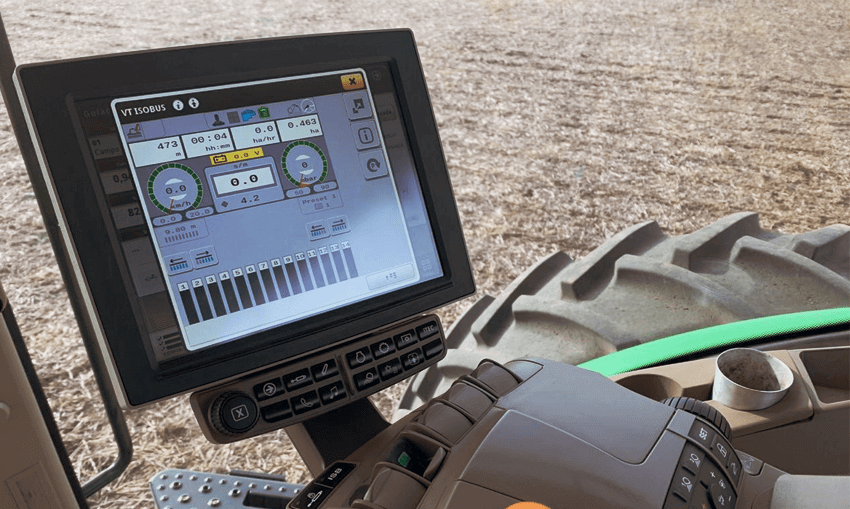
What is an ISOBUS system and how it works
ISOBUS is a standardized international communication protocol that allows different agricultural equipment to communicate with each other through a single common language.
With this term, we traditionally refer to the ISO 11783 standard "Tractors and machinery for agriculture and forestry - Serial control and data networks for communications". This legislation was born in the mid-90s from the need to standardize and centralize the control and man-machine interface in systems consisting of a tractor and work equipment, such as in the case of seeders or sprayers.
Specifically, an ISOBUS system allows the operator to connect and control different equipment using a single graphic terminal, called Universal Terminal (UT), for the management of all compatible ISOBUS implements, regardless of the manufacturer, instead of having a different terminal for every type of agricultural machinery.
Therefore, this ISOBUS protocol is the result of an agreement between the leading producers of agricultural machinery and equipment to solve compatibility problems, standardizing and normalizing the communication between the various machines, regardless of the manufacturer chosen.
What is an ISOBUS system made of?
An ISOBUS system provides the use of some fundamental components on the tractor, such as the mentioned above graphic terminal for interfacing, an electronic control unit relating to the same tractor, Tractor-ECU (T-ECU), which provides data such as speed, power take-off and consumption, and an ISOBUS connector to interface externally. To these elements, additional so-called "auxiliary" devices (AUX-O / N) can be added. One of them is a joystick, a practical tool that can significantly facilitate the operator using its operating functions.
On the equipment or operating machines, on the other hand, the presence of Implement-ECU is expected, such as components that exchange data between sensors or between devices intended to monitor the functional parameters of the machinery (such as the control of the distributed material or the treated surface), or even that can control devices based on the parameters set and the indications provided to them by the processes. In particular, these Implement-ECU communicate with the ISOBUS devices installed on the equipment through a connection to the connector present on the tractor itself. It is precisely through the latter that the data is powered and exchanged.
The ISOBUS system provides some functions that integrate the system with the possibility of managing particular operations, such as:
- TC-BAS - Basic Task Controller: allows you to provide information received from the equipment on the overall values regarding the work performed. In order to exchange data between the farm management system and the Task Controller, the ISO-XML data format must be used (only subsequently will it be possible to easily import the jobs into the Task Controller and export in final documentation);
- TC-GEO - Geo-based Task Controller: an additional capacity that allows you to acquire data based on position or to plan jobs based on the position of the agricultural machine on the field (for example, through the use of application maps);
- TC-SC - Task Controller Section Control: this allows you to automatically modify work sections based on the GPS position and the desired degree of overlap.
What are the possible applications and the possible advantages that can be obtained using an ISOBUS system?
As previously mentioned, with an ISOBUS system, it is possible to control all the activity done by the tractor and agricultural equipment on a single graphic terminal.
The exchange of information and data offered by these systems offers irreplaceable support and various advantages in various types of operations that can be carried out on the field, such as:
- It allows improving the quality of the cultivated products;
- It allows to optimize the yield according to the different working conditions, thanks to the multiple data collected in real-time on seeders and sprayers;
- Integrated with satellite geolocation systems (GPS), it allows to make a targeted distribution of the product, a function that helps to avoid overlapping or empty areas on the ground, and to view the treated surface directly on display in the cabin;
- Thanks to its modern automation systems, the use of the satellite precision systems makes it possible to increase the effectiveness and efficiency of the production process by saving fuel and pesticides (an aspect that clearly translates into savings economic for the farmer) but also to respect the environment, reducing waste to practically zero;
- It allows you to trace the entire agricultural production path and document it, for example, through reports;
- It reduces operator fatigue thanks to the automation of agricultural operations and increases his safety in the workplace.
In conclusion, we can say that the introduction of ISOBUS systems was a radical innovation in the field of agricultural technologies that have and will increasingly bring about countless advantages for end-users, machinery manufacturers and also the environment.
It is worth highlighting,
however, that ROJ systems are not ISOBUS but also that countless partnerships
with suppliers and ISOBUS system integrators have been developed and are
intended to be developed to better integrate ROJ Agri-Motion motors with their
control units, providing ROJ expertise on the application.

